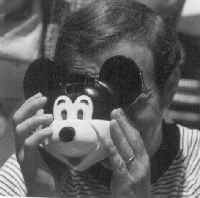

 Duke University Press
Duke University Press  250 pages
250 pages  $15.95
$15.95Upon returning from our Florida vacation this summer, the first question our friends and neighbors asked us was, "How was Disney World?" Stammering, almost apologetically, we told them we didn't visit the Magic Kingdom.
When trying to explain to most people that there are other things to do and see in Florida, you begin to get the feeling that it is almost un-American maybe even sacrilegious not to experience the magic of Disney.
After reading Inside the Mouse, I discovered that I was not alone in my suspicions about those rats Mickey and Minnie. How, you ask, can there be another side to Disney, the happiest place on Earth?
Inside the Mouse is a collection of essays from the Project on Disney, compiled by Duke University Press. The authors, most of them instructors and professors from Duke, offer a revealing behind-the-scenes look at the Disney machine.
Although a bit academic at times, the book does succeed, in an informal style, in presenting a serious cultural analysis of the Kingdom and its visitors.
From the start, you begin to wonder whether the Disney Empire is being run from the grave by its founder, Walt Elias Disney, dead since 1966. Knowing that he was dying, Disney recruited a camera crew in the months before his death and made a series of films in which he conducted staff meetings in front of an empty conference table. These film conferences apparently were held monthly until the 1980s.
Some Disney executives joked quietly, "This is necrophilia. We're working for a dead man." (The authors briefly mention the rumor, neither proving nor disproving, that Walt's corpse is frozen somewhere in California.)
Since recent successes at the box office, Disney has become, say its critics, one huge, multi-spigoted dispenser of schlock culture. Every item imaginable has been packaged to sell the Disney logo, and a visit to the Magic Kingdom usually turns the family vacation into a mega-shopping spree.
Despite all of its elaborate and technological trappings, Disney World, the authors believe, is nothing more than an enormous shopping mall providing a unique brand of "post-modern simulation." The end result is that visitors to the Magic Kingdom become one band of unreflective consumers eager to enjoy the benefits of a fake world.
One of the most interesting essays, I found, was "Team Disney: Working at the Rat." Disney's control of its labor force is apparently near total. Many workers refer to the park as the "Rat" or the "Mousetrap."
Spying on employees and guests is an everyday occurrence. Those who spy on the guests are called "foxes," and those who spy on employees are called "shoppers." Foxes carry cameras hoping to catch shoplifters or counterfeiters, and shoppers roam the park acting nasty to see if they can aggravate employees enough to make them step out of character.
Inside the Mouse offers a penetrating cultural analysis and an alternative ride through Disney's programmed Never-Never Land.
And, for the millions of tourists hoping to experience the magic and that warm-all-over-feeling, at a place where the environment is more real than real, where every ride runs to a computerized schedule, and where every backdrop offers a picture-perfect photo setting, then the Disney dreamscape, a kingdom without ants, snakes or muggers may still be the best family vacation out there.
John C. Christian III is a Columbia-based freelance reviewer.

© Copyright by POINT, 1995
Last modified 8/8/95